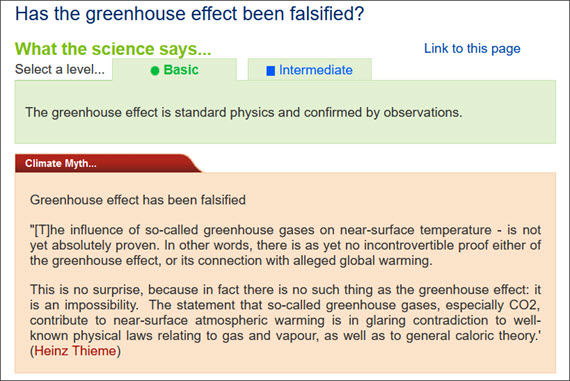
On February 14, 2023 we announced our Rebuttal Update Project. This included an ask for feedback about the added "At a glance" section in the updated basic rebuttal versions. This weekly blog post series highlights this new section of one of the updated basic rebuttal versions and serves as a "bump" for our ask. This week features "Has the greenhouse effect been falsified?". More will follow in the upcoming weeks. Please follow the Further Reading link at the bottom to read the full rebuttal and to join the discussion in the comment thread there.

Did you know that in the late 1700s, astronomers calculated the Earth-Sun distance to within 3% of the correct average value of 149.6 million kilometres? That was an incredible feat for the time, involving painstaking measurements and some pretty serious number crunching, with no help from computers.
Why is that mentioned here, you might ask. It's because not long afterwards, in the 1820s, French physicist Jean Joseph Baptiste Fourier made another crucial calculation. He worked out that at this distance from the Sun, Earth should have been an uninhabitable iceball.
Fourier suggested there must be some kind of insulating 'blanket' within the atmosphere. By the end of that century, Eunice Foote and John Tyndall had proved him quite correct through their experiments with various gases and Svante Arrhenius quantified matters in 1896, even calculating the effect of doubling the concentration of CO2. They had it largely figured out all that time ago.
If you are still sceptical about the existence of a greenhouse effect on Earth, there's something you can do in order to double-check. Go to the moon.
Well, you don't have to go personally, thanks to remote sensing and lunar landings by both unmanned and manned craft. Such intrepid expeditions mean we have a stack of data regarding lunar properties. The moon is pretty much the same distance from the Sun as Earth, but the lunar atmosphere is so thin it may as well not exist at all. There's virtually nothing to inhibit heat transfer, in or out.
In addition, the Moon turns but slowly on its axis compared to Earth. While a mean Solar day here lasts 24 hours, on the Moon it lasts just under a month. You get the best part of a fortnight of relentless Solar heating followed by a similar period of cooling in the long lunar night. So what's the temperature?
In the vicinity of the Lunar equator, daytime temperatures eventually reach a boiling hot 120oC. During the lunar night, that temperature drops away to -130° C. No atmosphere so no greenhouse effect. All that heat accumulated in the long lunar day just shoots straight back out into space. Nights on Earth may be much shorter, but nevertheless in the absence of a greenhouse effect they would be brutal.
Our approximately Earth-sized near neighbour, Venus, closer to the Sun, is different again. It has a massive dense atmosphere mostly consisting of CO2 with a side-helping of sulphur dioxide. Surface atmospheric pressure on Venus is so great that on Earth you would need to go a kilometre down in the ocean to find similar values. The planet rotates very slowly on its axis so days and nights are even longer than on the Moon. But unlike the Moon, Venus is always a hot place. Its surface temperature is over 450oC, day or night. An extreme greenhouse effect maintains that heat.
Remember: no atmosphere, no greenhouse effect and unimaginably cold lunar nights - but the example of Venus shows you can also have too much of a good thing. Earth really is a Goldilocks planet.
Please use this form to provide feedback about this new "At a glance" section. Read a more technical version below or dig deeper via the tabs above!
In case you'd like to explore more of our recently updated rebuttals, here are the links to all of them:
If you think that projects like these rebuttal updates are a good idea, please visit our support page to contribute!
Posted by John Mason on Tuesday, 5 December, 2023
 |
The Skeptical Science website by Skeptical Science is licensed under a Creative Commons Attribution 3.0 Unported License. |